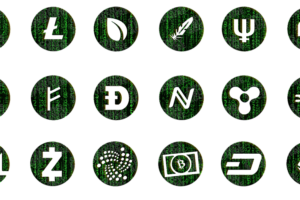Cryptocurrency is frequently in the news cycle, with articles that alternate between labeling it the future of global trade and an unsustainable Ponzi scheme. With so much bias, it can be hard for somebody who doesn’t yet know that much about crypto to form their own informed opinion on the subject. This article is intended to explain cryptocurrency in an open, accessible way that nearly anyone can understand. Hopefully, you can use this information to formulate your own opinion on crypto and its underlying blockchain technology instead of blindly trusting more biased news sources.
How Is Cryptocurrency Defined?
Put simply, crypto is any digital means of transferring value to somebody else, such as in exchange for goods or services. The term “cryptocurrency” was coined by the mysterious creator of Bitcoin, “Satoshi Nakamoto,” in 2008. Other prominent crypto tokens currently on the market include Ethereum, Ripple, Litecoin, and Monero.
Most crypto tokens run on blockchain technology, or decentralized public ledgers capable of recording an infinite number of crypto transactions. The methodology behind this is simple: Information is stored on virtual “blocks” that may be “chained” together to keep track of a token’s entire transaction history.
Every crypto transaction appears on the blockchain in three key components: Input, Amount, and Output. Both the Amount (how much money?) and Output (recipient) are self-explanatory, but the Input is a little more confusing. The Input is the crypto account (called a “wallet”) that originally provided the tokens to the account that is now transferring them to somebody else. It shows up on the blockchain as a random string of characters that act as a “username.” Supporters of cryptocurrency often argue that this system provides a variety of security advantages over more traditional online banking services.
Crypto Is Safer Than A Bank? Can You Elaborate on That?
In theory, the blockchain is unhackable because any hack would need to target multiple blocks at once to ensure the system maintains agreement with itself. It’s actually possible to trace any individual coin through every electronic account that it has ever been in. Whenever a new transaction is added to the blockchain, volunteer “miners” use computers to perform complicated math and ensure that all of the tokens involved are coming out of the accounts they are supposed to be in. If anything looks fishy, the transaction isn’t processed.
The blockchain is also decentralized, meaning that there is no central hub or authority figure that a hacker could target in order to bring the entire system down. Instead, decisions are made by a majority vote of a particular token’s community, while the underlying code is available for the public to inspect.
That said, the security of any computer network is only as good as its weakest link. Most crypto transactions are facilitated by sites called “exchanges” that lack the same security features as the blockchain. These exchange sites have been hacked in the past, including a prominent hack of the popular Mt. Gulg exchange in 2014 that siphoned off $473 million USD in digital assets before being noticed.
That Sounds Scary. Why Was Crypto Even Invented?
All economies need some way to exchange value in order to operate. Traditionally, fiat currencies such as the American dollar serve this function. However, these currencies are often limited to the country that backs them. Furthermore, many regions lack access to a money system as reliable as the American dollar or European euro, weakening the local economy.
A reliable digital currency could overcome these issues by providing a consistent means of exchange with zero reliance on geopolitical boundaries. Theoretically, this opens up new possibilities for global trade by removing the barriers to a truly competitive market. Many crypto backers also lack faith in traditional banking institutions, preferring to have a say in how their funds are stored rather than trusting a bank to handle them.
Contrary to popular belief, cryptocurrency was never intended as an investment vehicle. However, its wild price swings caused by the unchecked forces of supply and demand have encouraged investors to speculate on it in hopes of making a ton of money fast.
What Determines A Crypto Token’s Value?
Since cryptocurrencies have nothing akin to the Federal Reserve of the United States influencing their value, the community’s confidence in a token is one of the two determinants of its price. Bitcoin is traditionally valued the highest because it is the oldest coin on the market, and is, therefore, a “safe” investment. That said, even Bitcoin has fluctuated from $3,000 USD to $20,000 USD and back again in recent years. Other tokens can lose all of their value overnight if they are rendered technologically obsolete or associated with a bankrupt project.
The other key component of a token’s price is its planned circulation — or the “supply” side of supply and demand. For example, Bitcoin’s blockchain is coded such that no more than 21 million tokens can be circulating at any one time. Twenty-one million might sound like a lot, but it’s actually pretty low for a currency that hopes to dominate world trade. As such, the price of an individual Bitcoin can get quite high.
In contrast, a token called Ripple has a planned circulation of 100,000,000,000. There’s more than enough to go around, so an individual Ripple will never be worth that much money. Some crypto enthusiasts view this as a good thing, as it’s wildly impractical to buy mundane items such as a gallon of milk with a currency valued at thousands of dollars per unit. However, investors tend to support smaller circulations to leave maximal room for profit.
Is the Crypto Revolution Upon Us?
While crypto backers are great at pointing out the shortcomings of the current financial system, they are more hesitant to acknowledge the shortcomings of current blockchain technology. While Bitcoin miners can process anywhere from 3-7 transactions per second depending on available resources, Visa can handle 24,000+ in the same time frame. The fact that cryptocurrency is constantly fluctuating in value also makes it harder for businesses to charge a consistent price for a product, as something that costs one Bitcoin could be $10,000 today and $3,000 tomorrow.
Miners also charge a processing fee for their services that could potentially render a transaction uneconomical. For instance, the Bitcoin blockchain theoretically supports transactions as small as a “Satoshi” (0.00000001 Bitcoins), but actually purchasing something at that price is foolish if you pay a transaction fee of double or even triple the product’s purchase price.
Of course, many tokens have potential as well. Ethereum has a programmable blockchain that allows for “smart contracts,” or set contracts that fulfill themselves once prescribed conditions have been met. Imagine only paying for products after they arrive, or writing an electronic will that automatically distributes your digital assets when you pass away.
In short, crypto isn’t quite primed to take over the world yet, but some of what it can do could prove to be a powerful force on future trade. What do you think the future holds for cryptocurrency?





Most Commented Posts